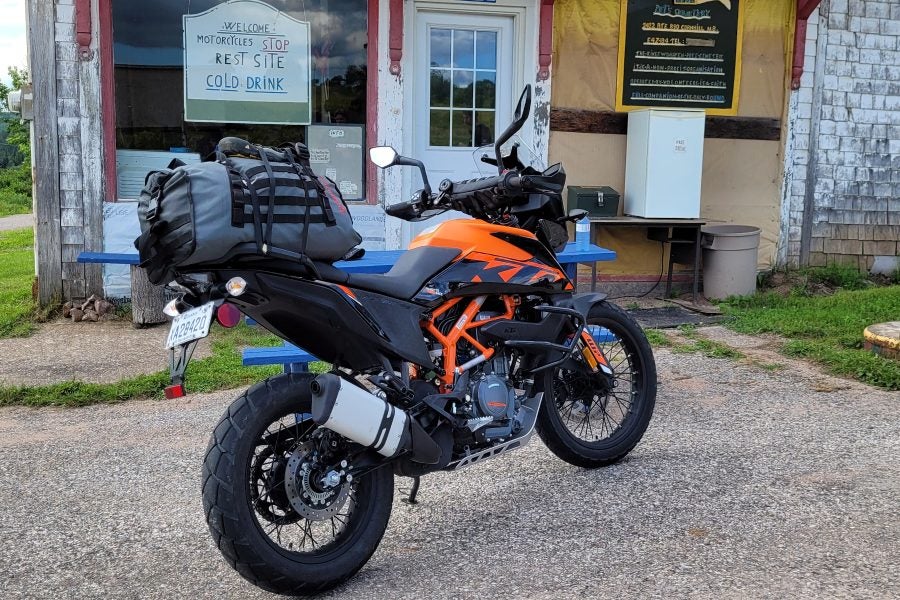Motorcycle luggage only reallyneedsto do three things: keep our gear dry, clean, and strapped securely to the motorcycle. Turkana Gear offers wraparound tailbags, handlebar pouches and other trick gear (the company is run by well-known ADVers who build the kind of kit they use themselves)—but with the Turkana Duffalo bags, they kept things simple. Kind of.
I got one of these as a sample unit for testing this summer, and have been using it on moto trips and other getaways. Here’s a look at how well it works.

Note the MOLLE webbing on both sides and back, allowing you to attach accessories to suit the bag’s orientation on the bike. Photo: Turkana
Keep it simple, stupid
The Duffalo series (available in 25-liter and 40-liter capacity) is, at its base, a simple duffel bag with rolltop closure. There is nothing revolutionary about the design; it’s not made to wrap around a bike’s tail section. There’s no quick-release plate, to attach it to a rack. But, it’s more than just a great big bag; it does have a couple of tricks up its sleeve.
The outside of the bag is made of Rhinocote fabric (Turkana’s name for it, not ours). It’s a rugged synthetic with “a high tear, shaving and abrasion resistance.” I didn’t crash my motorcycle to test this claim, but I will say it seems to be pretty sturdy stuff so far, with no indication that it will come apart with normal bashing and banging that moto luggage gets. After days strapped down on trips through eastern Canada, there is no visible wear on any of the seams or fabric.
The Duffalo comes with an inner liner made of waterproof/dustproof fabric. Velcro-style material connects the mouth of the liner bag to the mouth of the outer bag, so when you open the Duffalo up, you get direct access to the inner liner bag.
We’ve seen this kind of design with other luggage manufacturers in the past, and there are some advantages to building soft bags this way. It’s robust, and allows for easy, lasting repairs of both the outer bag and the liner. It also allows you to attach straps to the mounting points on the outer bag without worrying they’ll pull out and ruin your waterproofing.
Turkana includes a cushion material between the bottom of the outer bag and the IP67-rated liner, which should help prevent the material from chafing when strapped down to your bike.
The disadvantages? I suppose this construction is more complicated, which might drive up the price, and it’s heavier than single-layer construction. But light weight doesn’t do you much good if your earthly belongings are spilled over the trail when your bags ripped open in a simple get-off…
The Duffalo also comes with MOLLE-style webbing all over the surface. This is often used for visual effect on modern ADV luggage, but on the Duffalo, it’s quite practical. Turkana itself offers accessory pouches (the BushBaby utility bag and the Oxpacker bottle holder) which nicely thread into the MOLLE webbing, and you can find a lot of other gear on Amazon/eBay/wherever that will also attach handily.

加载下来,向北。你是富裕的莫unting the Duffalo to a rack, if possible. Photo: Zac Kurylyk
Setting up the Duffalo
Again, there’s none of the quick-release design that’s so popular these days—you plunk the Duffalo onto your bike’s tail rack, and strap it down. Turkana doesn’t supply any straps with the Duffalo. You must supply your own.
On my longest trip with the Duffalo, I strapped it down to my Bandit 1200, then rode to Quebec and swapped it over to a Husqvarna Norden 901 Adventure for a trip to James Bay. There is a cautionary tale in my experience here (but it was my fault, not Turkana’s).
Most of my camping and travel gear went into the Duffalo; I threw some cooking equipment into the OxPacker pouch and MOLLE-webbed it to one end of the pack. I put some fishing gear into the BushBaby bag and MOLLE-webbed it to the other end of the pack. Then, I strapped the bag down to the Bandit’s rear seat with a bungee and two ROK Straps. In Quebec, I quickly switched over to the Husqvarna’s accessory rack, which the Duffalo fit nicely, and carried onwards.

Keep raingear and other stuff you might want during the day (like that PVC fishing rod case) handily stored outside the bag. Photo: Zac Kurylyk
Day-to-day usage
The whole James Bay expedition turned into a disaster (literally—read the next issue of ADVrider’s print mag), but the Duffalo held up very nicely through all the riding, even in some very bad weather. Torrential rain, dust, the Duffalo shed it all. I tried to keep raingear or anything else I might need mid-day strapped to the top of the bag, or in the auxiliary pouches, my backpack or the handlebar bag, because I didn’t want to have to unstrap the Duffalo to access the interior.
On a couple of occasions where I had to access the Duffalo mid-day, I did manage to just undo the rolltop and sneak my rain jacket out of the bag without completely removing/reinstalling the bag. This is not ideal and if you’re using this duffel, you will want to keep your through-the-day items where they’re easily accessed (like in those MOLLE-webbed pouches). This is not a design error; it’s just the nature of using a strapped-down soft bag.
Whether I was on-pavement at high speed or rolling around on rough fire roads, I didn’t find the Duffalo shifting at all, when sitting solidly on the rack. Strap it down right, and it’ll stay in place. I do like that Turkana doesn’t charge you for straps you might not want or need; there are plenty of good straps on the market already, and most of us already own a selection. While I used ROK Straps, I think Nelson-Rigg’sRigg Strapsmight actually be better, depending on what kind of rack you’re using. You can just use old-fashioned bungees if you want, or a cam-buckle strap, or Giant Loop’sPronghorn straps—you’ll figure it out.

Hooking a set of Rigg Straps into those vertical MOLLE strips would make for a very solid mount on most wide moto racks. Photo: Zac Kurylyk
Be careful!
詹姆士湾骑之后,我发现我做了一个mistake when I strapped the Duffalo to the Bandit’s seat. Because the seat didn’t support it as well as a rack, it had shifted a bit in-flight, and the attachment bungee had worn a big scar in the B12’s bodywork. Alas! Good thing it was just an old, beat-up warhorse and not an expensive new machine. So, with that in mind, I would say the Duffalo works best with a tail rack; you can strap it to a seat, but you run more risk of having things shift around, which can scratch up your bike. Again—this was my mistake, not a problem with the equipment, and I’m just telling you so you don’t follow my bad example.

Theoretically, you could remove the inner liner and use that as a carry-your-stuff-into-the-hotel bag, leaving the Duffalo’s exterior bag on your bike. I don’t see how that would make life easier, though. Photo: Turkana
Non-moto utility
As the riding season winds down, I will say I’ve found the Duffalo pretty handy. Because it’s long and wide, it’ll swallow a tent, sleeping bag, mattress, clothes, and enough other gear for a weekend trip—maybe add a tankbag for the stuff you need in-flight (camera, snacks, etc.).
However, I’ve also started using the Duffalo for other trips—family vacations in the SUV, that sort of thing. It works well becauseit’s just a big duffel bag, not some complicated U-shaped saddlebag. It’s perfectly practical as normal-use luggage. I don’t think you could get away with the 40-liter version as carry-on for flights today; there’s no way I could jam it under an airplane seat. But if you are willing to take your chances with the baggage hold, the 40-liter Duffalo might work well for fly-and-ride motorcycle trips, especially if you’re not camping.

Of course, adding the MOLLE accessory pouches will drive up the price. They do make the bag a lot more useful in day-to-day usage, though, and you could theoretically add other MOLLE-ready gear, if you own some. Photo: Turkana
Would I buy?
The old “would a cheapskate buy ’em” test. In this case, the answer is yes—if I was looking for an all-round-useful tailbag, I’d buy one of these with my hard-earned Canadian shekels. Turkana sells to the US throughADVmotorcycleparts.com, where asking price is $140 USD for the 40L bag, $125 for the 25L bag (Canadians, tryADVmotorcycleparts.ca, where you’ll pay $151 CAD and $169 CAD respectively).
This is not a lot of money for some riders; it will be a more significant expense for others, but not crazy high. But the gear seems to hold up well, and its usability in non-riding scenarios might make it attractive to thrifty riders. Even the chintziest 40L dry bag will set you back around $50 online, and that comes with much wimpier construction, and no expandability via MOLLE straps. And, some buyers may like the fact that Turkana gear is made in South Africa, with input and design from well-known adventure travelers.
Find more photos and info at Turkana’s sitehere.







